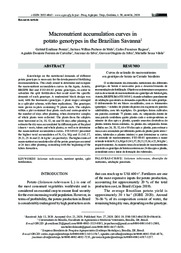Macronutrient accumulation curves in potato genotypes in the Brazilian Savanna.
Macronutrient accumulation curves in potato genotypes in the Brazilian Savanna.
Autoria: PEREIRA, G. E.; MELO, J. W. P. de; RAGASSI, C. F.; CARVALHO, A. D. F. de; SILVA, J. da; SILVA, G. O. da; VILELA, M. S.
Resumo: This study aimed to determine and compare the macronutrient accumulation curves in the Agata, Asterix, BRSIPR Bel and F183-08-01 potato genotypes, in order to subsidize the split fertilization that could meet the specific demands of each genotype. A randomized block design was used, with the treatments (genotypes × plant stages) arranged in a split-plot scheme, with three replications. The genotypes were grown in plots containing 75 plants each. The subplots within a plot contained four plants each and corresponded to the number of days after planting, when destructive samples of whole plants were collected. The plants from the subplots were harvested at 24, 38, 52, 66 and 80 days after planting, to estimate the dry mass accumulated by different parts of the plant (shoots + roots, tubers and whole plants), as well as to determine the macronutrient accumulation curves. F183-08-01 presented the highest total accumulation of N, Ca, Mg and S (141.37, 29.21, 25.16 and 22.36 kg ha-1, respectively). The highest rates of macronutrient accumulation for all the potato genotypes occurred at 24 days after planting, coinciding with the beginning of the tubers formation.
Ano de publicação: 2020
Tipo de publicação: Artigo de periódico
Unidade: Embrapa Hortaliças
Palavras-chave: Adubação, Nutrient uptake, Solanum Tuberosum, Split application
Observações
1 - Por padrão são exibidas publicações dos últimos 20 anos. Para encontrar publicações mais antigas, configure o filtro ano de publicação, colocando o ano a partir do qual você deseja encontrar publicações. O filtro está na coluna da esquerda na busca acima.
2 - Para ler algumas publicações da Embrapa (apenas as que estão em formato ePub), é necessário ter, no celular ou computador, um desses softwares gratuitos. Sistemas Android: Google Play Livros; IOS: iBooks; Windows e Linux: software Calibre.
Acesse outras publicações
Acesse a Base de Dados da Pesquisa Agropecuária (BDPA) para consultar o acervo completo das bibliotecas da Embrapa.

